artificial flowers are a great option for adding colour to your home without compromising on longevity. They are also much more environmentally friendly than relying on the cut flower industry.
Today’s silk flowers are almost undecipherable on film, and some even include little touches like stamens and thorns. But how do they achieve such realistic looks?
Table of Contents
History
The first artificial flowers were made in China, during the Tang Dynasty more than 1,500 years ago. These early creations were created for royalty, aristocrats, and noblewomen to use in their hair as elegant hair ornaments.
Over the centuries, people have used a variety of materials to replicate the beauty of flora. Metal and wax have been common choices. Replicas of flowers have even been discovered in ancient caves!
By the 1920s, florists started utilizing silk flowers to supplement their flower displays and arrangements. Over time, a variety of other textiles began to be used in the production of artificial flowers. The use of these materials allowed flower makers to experiment with new colors and styles that are now seen in modern artificial flowers. Many of these designs showcase symbolic meanings that evoke specific emotions. This art of arranging has grown into an industry that is widely known for its ability to enhance any environment.
Materials
Creating flowers of the highest quality requires a lot of materials. Artificial flowers are created from silk, polyester, and paper among other fabrics that vary depending on the type of flower and market. The manufacturing process involves cutting the fabric to petal size, colouring them, and pressing them into special moulds to give them shape. The petals are then joined to stems constructed of tape- or paper-wrapped wires.
Flocking is another manufacturing technique that is used to make fake flowers appear furry and velvety. This is often seen on the stems of fake gerberas, poinsettias, and holly.
The most popular material for flowers is polyester. It achieves a lifelike look that is hard to distinguish even from a close distance. It also accepts dyes well and is sturdy enough to endure a long period of time. It is cheaper than other fabrics but still looks beautiful and does not require any maintenance. It is a great choice for weddings because it can be mixed in with real florals and other decorative elements that would bust most people’s budgets.
Processes
The process used for the production of artificial flowers varies according to the material and the market. The most common is polyester, which can be dyed to match almost any color a florist needs. Other materials include cotton, parchment, latex, rubber and sateen (for larger, bold-colored flowers or plant parts such as berries).
The first step in creating an artificial flower is to put the petal into gelatine so that it can stiffen. Then the petals are pressed into moulds to create different shapes, such as a rose or a daisy.
For stems, a plastic material that can be molded around a wire is used. The wire is then inserted into the center of the flower to hold it together. This process can be complicated and time-consuming, especially when making high-end arrangements. However, new processes like permastem and permasilk have helped to improve the structure of these flowers and make them more durable. These improvements are expected to help the artificial flower industry continue to grow.
Applications
Artificial flowers are used in home decoration, event setups, and gifts. They are also a great alternative for people who are allergic to fresh flowers. Unlike real flowers, they don’t produce any pollen and won’t trigger hay fever or other allergies. They also last longer than their natural counterparts and will stay in perfect condition all year round.
Faux flowers are also a great alternative for weddings and special occasions. However, they are a bit more expensive than their real counterparts. But, with advances in technology, fake flowers are now extremely realistic.
A wide variety of fabrics, plastics, and other materials are used to make artificial flowers. Among them, polyester has become the fabric of choice for flower makers and buyers due to its low cost and ability to accept dyes and glues. These fabrics are then cut into the shapes of leaves, petals, and stems. Afterward, the flowers are assembled with the help of other materials such as wires, foams, and adhesives.

